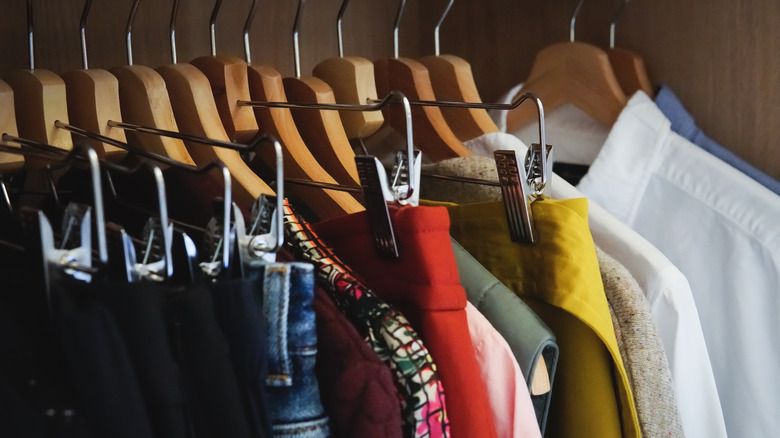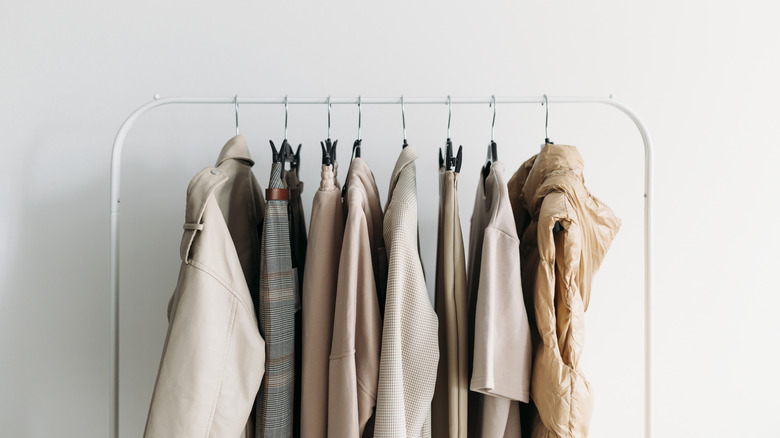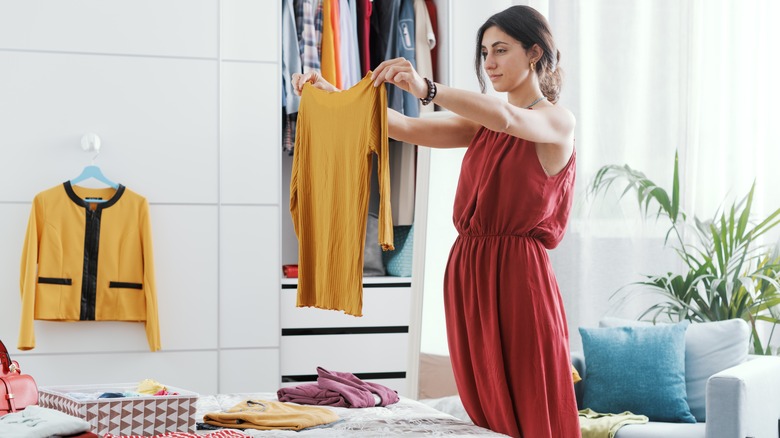Who Are 'Capsule Wardrobes' Even For? Why 'Less Is More' Doesn't Work For Everyone
Capsule wardrobes are the fashion counter-attack on maximalism. While the numbers seem to vary, some capsule wardrobes consist of 10-20 items of clothing, while others say that nearly forty items is the sweet spot. Clearly, the specific number is up to you, but the point is that building a capsule wardrobe means you curate a small grouping of pieces that you love to wear and that work well together. The pieces are versatile and can function interchangeably to create an entire array of looks.
Sure, capsule wardrobes are appealing for a number of reasons. They can create simplicity when dressing and free up space in your closet. The strategy might also improve finances since you're buying fewer items and can ward off decision fatigue. All of these promises seem good, even appealing. But the downsized wardrobe practice might not be for everyone.
The capsule wardrobe formula doesn't leave a lot of wiggle room for personal taste. And, not everyone wants to be minimal. To be fair, personal expression can still happen creatively with capsule wardrobes. But we're still not convinced that "less is more" works for everyone for several different reasons.
How misleading the capsule wardrobe concept really is
The capsule wardrobe pitches itself as a safeguard against crowded closets and overspending. But the truth is that the capsule wardrobe lifestyle can be misleading. For instance, Un-Fancy explains that 37 pieces is the ideal number for a capsule wardrobe, but suggests having four different capsule wardrobes throughout the year, to accommodate each season. That's a lot more clothing than you may have anticipated. What's touted as a single wardrobe has suddenly become several single wardrobes. There are capsule wardrobes for travel, athletics, special events, and on and on. Less is suddenly becoming more and more.
It's not just that the capsule wardrobe ends up becoming several capsule wardrobes, but the price point is often misleading. The wardrobe is lauded as a money-saving strategy because you're buying investment pieces, that can be worn over and over again. If you're upper middle class, this might work, but for many, the investment cost is simply too high. For instance, Vogue's selection of capsule wardrobe looks begins with a range from the more affordable Everlane brand. However, they also suggest a range of pieces from Khaite and Gucci, with a plain, black top costing $1,160 and a pleated leather skirt costing $5,500. The mantra is "buy less," while the price tag can be super high. The average person isn't going to be able to purge their entire wardrobe to make space for a skirt worth several thousand dollars.
A capsule wardrobe isn't practical for everyone
There are other problems with the capsule wardrobe that might make it impossible for everybody to follow suit. The language around creating a capsule wardrobe speaks to intentionality. One mindfully curates the wardrobe. One streamlines a classical look. One edits their pieces. This in and of itself can take a lot of effort and creativity. Trying to create new looks by reimagining the same pieces can be stressful and time-consuming.
There are other factors at play too. Not everyone can do laundry as frequently as is required with a capsule wardrobe. For others who work, raise kids, and run a household, a capsule wardrobe that's meant to satisfy all of these responsibilities is unrealistic. Simply, more clothing is needed to fit these demands.
On top of this, capsule wardrobes are lauded as being the environmental choice since they require fewer items. However, not everyone can afford the price tag of longer-lasting, ethical pieces. In many cases, individuals buy fast fashion not because they hate the planet but because it's all they can afford. The opportunity to avoid fast fashion can be a privilege in itself. Ethical brands tend to be more expensive. So the capsule wardrobe trend certainly isn't for everyone. Often, it's just a marketing tool for brands to sell luxury items, justified under the ruse that you only need a few pieces.


